Critical Analysis: Australian Pharmaceutical Benefits Scheme & Usage
VerifiedAdded on 2023/06/12
|12
|2721
|492
Essay
AI Summary
This essay critically analyzes the Australian Pharmaceutical Benefits Scheme (PBS) and the high rate of medicine consumption in Australia. It explores the costs associated with the PBS, funded by taxpayers, and examines the types of medicines consumed, including general and veteran's medicines. The essay discusses issues such as the lengthy analysis process for listing new medicines, the high cost of approved medicines, and potential misuse of the program leading to increased drug consumption. It highlights the government's efforts to provide quality healthcare through subsidized medicines but also points out the need for better control over drug consumption and consideration of public opinion in budgetary decisions. The analysis incorporates statistical data on government expenditure and drug usage, emphasizing the importance of accessible healthcare balanced with responsible resource management. Desklib provides access to similar solved assignments and past papers for students.
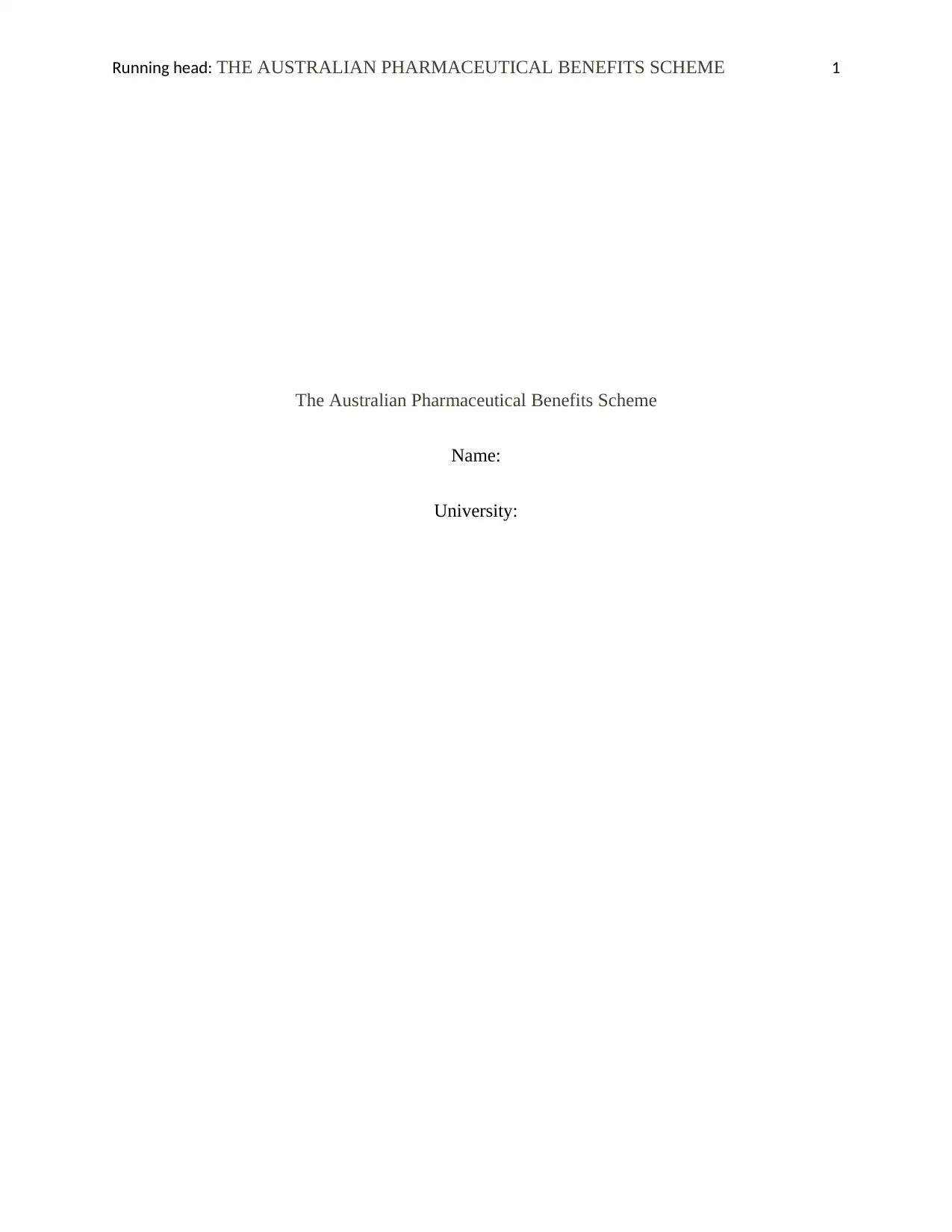
Running head: THE AUSTRALIAN PHARMACEUTICAL BENEFITS SCHEME 1
The Australian Pharmaceutical Benefits Scheme
Name:
University:
The Australian Pharmaceutical Benefits Scheme
Name:
University:
Paraphrase This Document
Need a fresh take? Get an instant paraphrase of this document with our AI Paraphraser
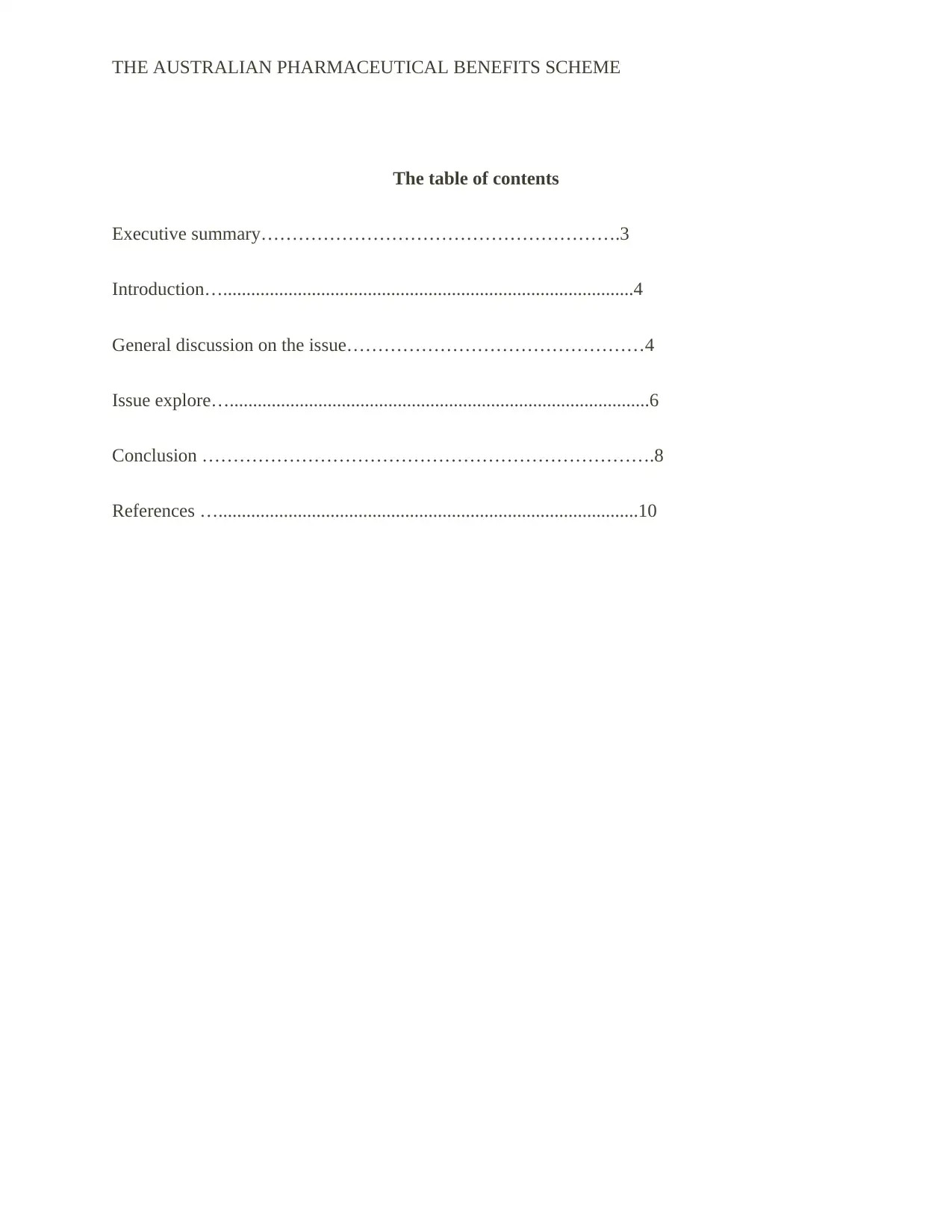
THE AUSTRALIAN PHARMACEUTICAL BENEFITS SCHEME
The table of contents
Executive summary………………………………………………….3
Introduction…........................................................................................4
General discussion on the issue…………………………………………4
Issue explore…..........................................................................................6
Conclusion ……………………………………………………………….8
References …..........................................................................................10
The table of contents
Executive summary………………………………………………….3
Introduction…........................................................................................4
General discussion on the issue…………………………………………4
Issue explore…..........................................................................................6
Conclusion ……………………………………………………………….8
References …..........................................................................................10
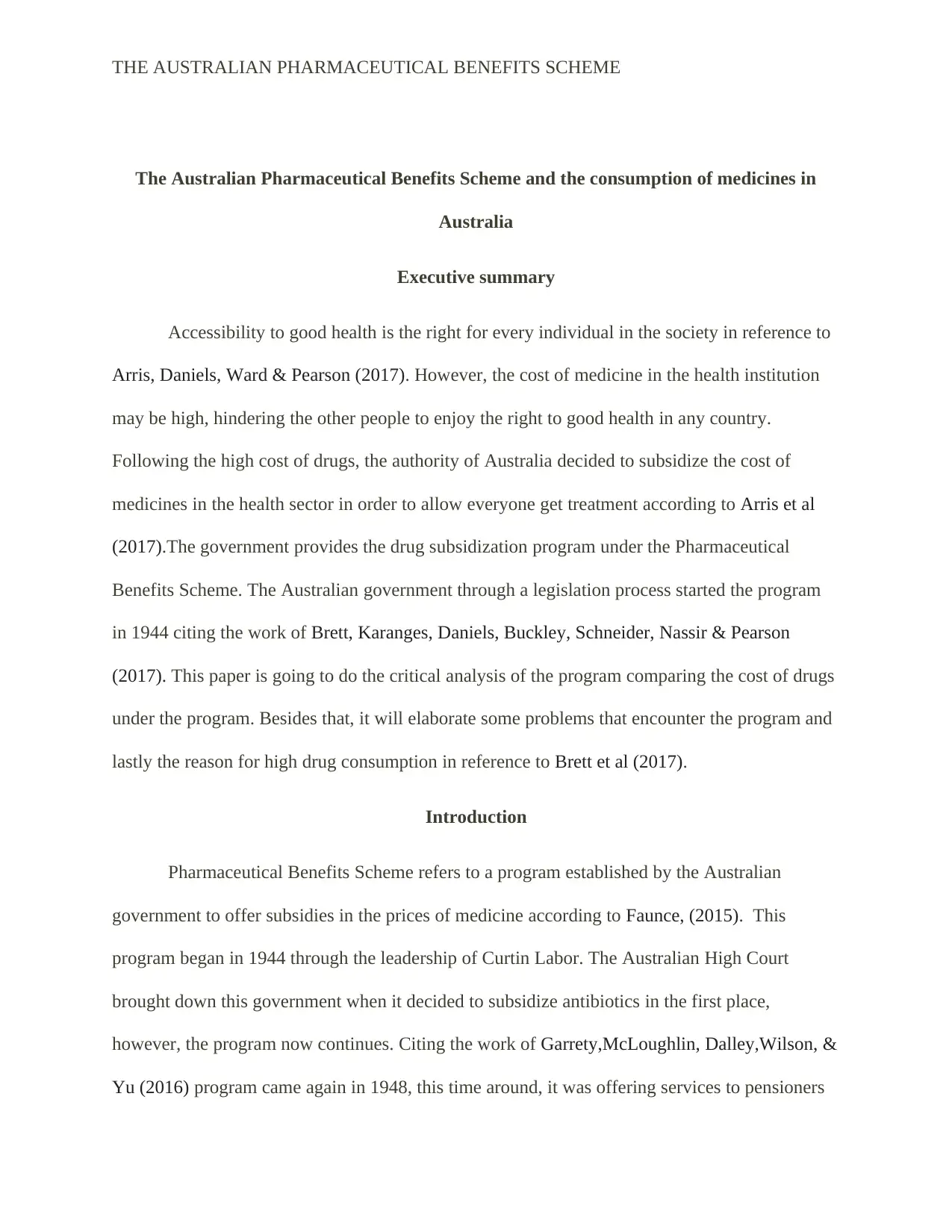
THE AUSTRALIAN PHARMACEUTICAL BENEFITS SCHEME
The Australian Pharmaceutical Benefits Scheme and the consumption of medicines in
Australia
Executive summary
Accessibility to good health is the right for every individual in the society in reference to
Arris, Daniels, Ward & Pearson (2017). However, the cost of medicine in the health institution
may be high, hindering the other people to enjoy the right to good health in any country.
Following the high cost of drugs, the authority of Australia decided to subsidize the cost of
medicines in the health sector in order to allow everyone get treatment according to Arris et al
(2017).The government provides the drug subsidization program under the Pharmaceutical
Benefits Scheme. The Australian government through a legislation process started the program
in 1944 citing the work of Brett, Karanges, Daniels, Buckley, Schneider, Nassir & Pearson
(2017). This paper is going to do the critical analysis of the program comparing the cost of drugs
under the program. Besides that, it will elaborate some problems that encounter the program and
lastly the reason for high drug consumption in reference to Brett et al (2017).
Introduction
Pharmaceutical Benefits Scheme refers to a program established by the Australian
government to offer subsidies in the prices of medicine according to Faunce, (2015). This
program began in 1944 through the leadership of Curtin Labor. The Australian High Court
brought down this government when it decided to subsidize antibiotics in the first place,
however, the program now continues. Citing the work of Garrety,McLoughlin, Dalley,Wilson, &
Yu (2016) program came again in 1948, this time around, it was offering services to pensioners
The Australian Pharmaceutical Benefits Scheme and the consumption of medicines in
Australia
Executive summary
Accessibility to good health is the right for every individual in the society in reference to
Arris, Daniels, Ward & Pearson (2017). However, the cost of medicine in the health institution
may be high, hindering the other people to enjoy the right to good health in any country.
Following the high cost of drugs, the authority of Australia decided to subsidize the cost of
medicines in the health sector in order to allow everyone get treatment according to Arris et al
(2017).The government provides the drug subsidization program under the Pharmaceutical
Benefits Scheme. The Australian government through a legislation process started the program
in 1944 citing the work of Brett, Karanges, Daniels, Buckley, Schneider, Nassir & Pearson
(2017). This paper is going to do the critical analysis of the program comparing the cost of drugs
under the program. Besides that, it will elaborate some problems that encounter the program and
lastly the reason for high drug consumption in reference to Brett et al (2017).
Introduction
Pharmaceutical Benefits Scheme refers to a program established by the Australian
government to offer subsidies in the prices of medicine according to Faunce, (2015). This
program began in 1944 through the leadership of Curtin Labor. The Australian High Court
brought down this government when it decided to subsidize antibiotics in the first place,
however, the program now continues. Citing the work of Garrety,McLoughlin, Dalley,Wilson, &
Yu (2016) program came again in 1948, this time around, it was offering services to pensioners
⊘ This is a preview!⊘
Do you want full access?
Subscribe today to unlock all pages.

Trusted by 1+ million students worldwide
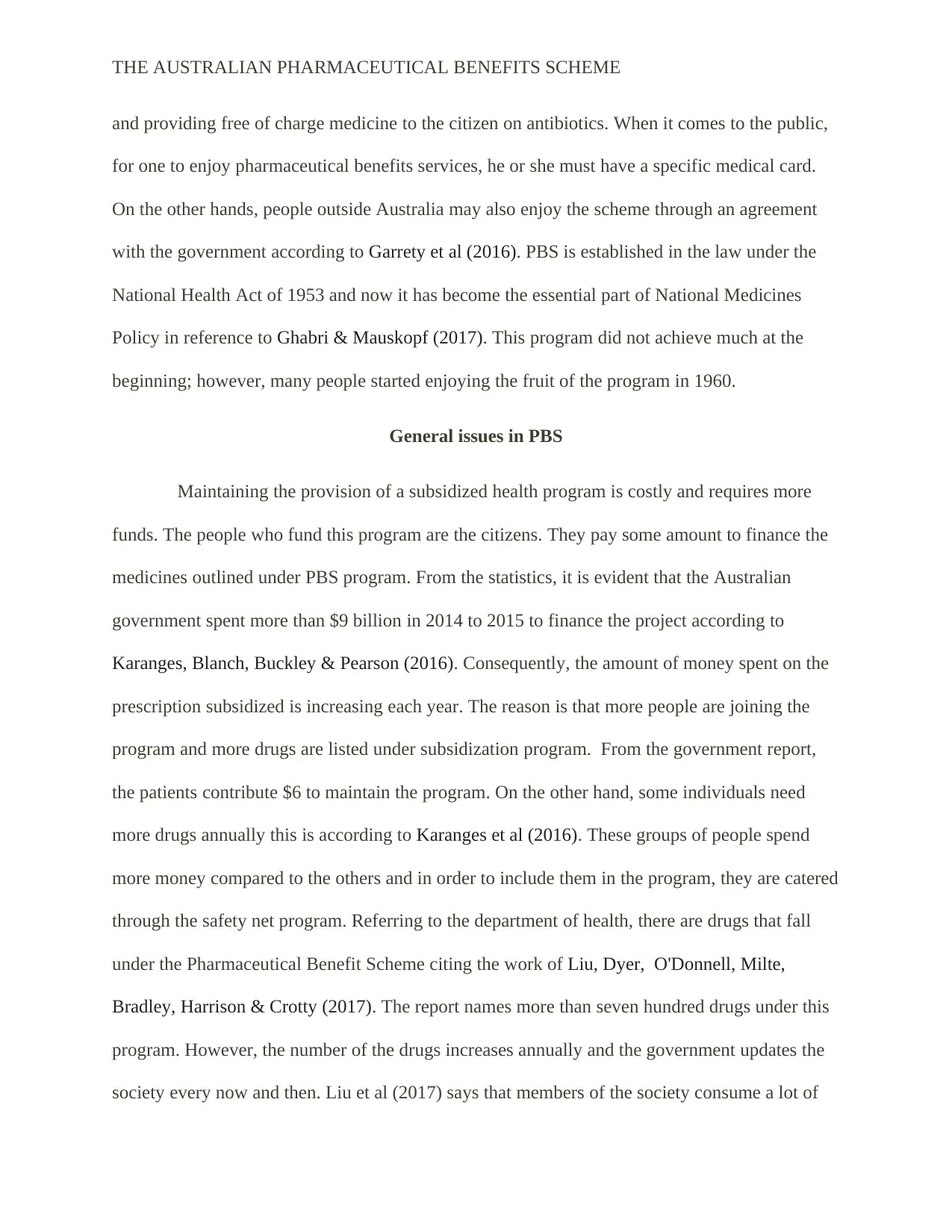
THE AUSTRALIAN PHARMACEUTICAL BENEFITS SCHEME
and providing free of charge medicine to the citizen on antibiotics. When it comes to the public,
for one to enjoy pharmaceutical benefits services, he or she must have a specific medical card.
On the other hands, people outside Australia may also enjoy the scheme through an agreement
with the government according to Garrety et al (2016). PBS is established in the law under the
National Health Act of 1953 and now it has become the essential part of National Medicines
Policy in reference to Ghabri & Mauskopf (2017). This program did not achieve much at the
beginning; however, many people started enjoying the fruit of the program in 1960.
General issues in PBS
Maintaining the provision of a subsidized health program is costly and requires more
funds. The people who fund this program are the citizens. They pay some amount to finance the
medicines outlined under PBS program. From the statistics, it is evident that the Australian
government spent more than $9 billion in 2014 to 2015 to finance the project according to
Karanges, Blanch, Buckley & Pearson (2016). Consequently, the amount of money spent on the
prescription subsidized is increasing each year. The reason is that more people are joining the
program and more drugs are listed under subsidization program. From the government report,
the patients contribute $6 to maintain the program. On the other hand, some individuals need
more drugs annually this is according to Karanges et al (2016). These groups of people spend
more money compared to the others and in order to include them in the program, they are catered
through the safety net program. Referring to the department of health, there are drugs that fall
under the Pharmaceutical Benefit Scheme citing the work of Liu, Dyer, O'Donnell, Milte,
Bradley, Harrison & Crotty (2017). The report names more than seven hundred drugs under this
program. However, the number of the drugs increases annually and the government updates the
society every now and then. Liu et al (2017) says that members of the society consume a lot of
and providing free of charge medicine to the citizen on antibiotics. When it comes to the public,
for one to enjoy pharmaceutical benefits services, he or she must have a specific medical card.
On the other hands, people outside Australia may also enjoy the scheme through an agreement
with the government according to Garrety et al (2016). PBS is established in the law under the
National Health Act of 1953 and now it has become the essential part of National Medicines
Policy in reference to Ghabri & Mauskopf (2017). This program did not achieve much at the
beginning; however, many people started enjoying the fruit of the program in 1960.
General issues in PBS
Maintaining the provision of a subsidized health program is costly and requires more
funds. The people who fund this program are the citizens. They pay some amount to finance the
medicines outlined under PBS program. From the statistics, it is evident that the Australian
government spent more than $9 billion in 2014 to 2015 to finance the project according to
Karanges, Blanch, Buckley & Pearson (2016). Consequently, the amount of money spent on the
prescription subsidized is increasing each year. The reason is that more people are joining the
program and more drugs are listed under subsidization program. From the government report,
the patients contribute $6 to maintain the program. On the other hand, some individuals need
more drugs annually this is according to Karanges et al (2016). These groups of people spend
more money compared to the others and in order to include them in the program, they are catered
through the safety net program. Referring to the department of health, there are drugs that fall
under the Pharmaceutical Benefit Scheme citing the work of Liu, Dyer, O'Donnell, Milte,
Bradley, Harrison & Crotty (2017). The report names more than seven hundred drugs under this
program. However, the number of the drugs increases annually and the government updates the
society every now and then. Liu et al (2017) says that members of the society consume a lot of
Paraphrase This Document
Need a fresh take? Get an instant paraphrase of this document with our AI Paraphraser
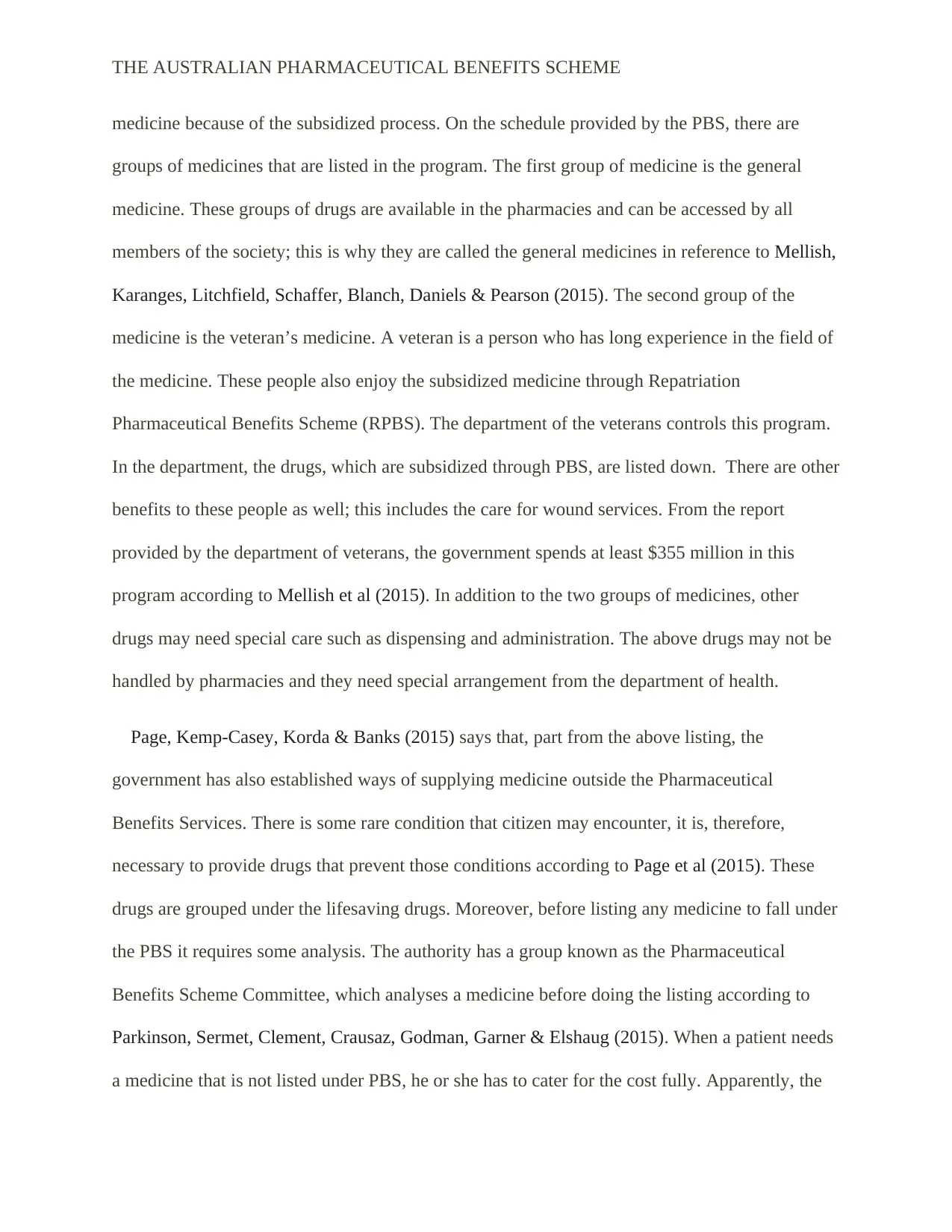
THE AUSTRALIAN PHARMACEUTICAL BENEFITS SCHEME
medicine because of the subsidized process. On the schedule provided by the PBS, there are
groups of medicines that are listed in the program. The first group of medicine is the general
medicine. These groups of drugs are available in the pharmacies and can be accessed by all
members of the society; this is why they are called the general medicines in reference to Mellish,
Karanges, Litchfield, Schaffer, Blanch, Daniels & Pearson (2015). The second group of the
medicine is the veteran’s medicine. A veteran is a person who has long experience in the field of
the medicine. These people also enjoy the subsidized medicine through Repatriation
Pharmaceutical Benefits Scheme (RPBS). The department of the veterans controls this program.
In the department, the drugs, which are subsidized through PBS, are listed down. There are other
benefits to these people as well; this includes the care for wound services. From the report
provided by the department of veterans, the government spends at least $355 million in this
program according to Mellish et al (2015). In addition to the two groups of medicines, other
drugs may need special care such as dispensing and administration. The above drugs may not be
handled by pharmacies and they need special arrangement from the department of health.
Page, Kemp-Casey, Korda & Banks (2015) says that, part from the above listing, the
government has also established ways of supplying medicine outside the Pharmaceutical
Benefits Services. There is some rare condition that citizen may encounter, it is, therefore,
necessary to provide drugs that prevent those conditions according to Page et al (2015). These
drugs are grouped under the lifesaving drugs. Moreover, before listing any medicine to fall under
the PBS it requires some analysis. The authority has a group known as the Pharmaceutical
Benefits Scheme Committee, which analyses a medicine before doing the listing according to
Parkinson, Sermet, Clement, Crausaz, Godman, Garner & Elshaug (2015). When a patient needs
a medicine that is not listed under PBS, he or she has to cater for the cost fully. Apparently, the
medicine because of the subsidized process. On the schedule provided by the PBS, there are
groups of medicines that are listed in the program. The first group of medicine is the general
medicine. These groups of drugs are available in the pharmacies and can be accessed by all
members of the society; this is why they are called the general medicines in reference to Mellish,
Karanges, Litchfield, Schaffer, Blanch, Daniels & Pearson (2015). The second group of the
medicine is the veteran’s medicine. A veteran is a person who has long experience in the field of
the medicine. These people also enjoy the subsidized medicine through Repatriation
Pharmaceutical Benefits Scheme (RPBS). The department of the veterans controls this program.
In the department, the drugs, which are subsidized through PBS, are listed down. There are other
benefits to these people as well; this includes the care for wound services. From the report
provided by the department of veterans, the government spends at least $355 million in this
program according to Mellish et al (2015). In addition to the two groups of medicines, other
drugs may need special care such as dispensing and administration. The above drugs may not be
handled by pharmacies and they need special arrangement from the department of health.
Page, Kemp-Casey, Korda & Banks (2015) says that, part from the above listing, the
government has also established ways of supplying medicine outside the Pharmaceutical
Benefits Services. There is some rare condition that citizen may encounter, it is, therefore,
necessary to provide drugs that prevent those conditions according to Page et al (2015). These
drugs are grouped under the lifesaving drugs. Moreover, before listing any medicine to fall under
the PBS it requires some analysis. The authority has a group known as the Pharmaceutical
Benefits Scheme Committee, which analyses a medicine before doing the listing according to
Parkinson, Sermet, Clement, Crausaz, Godman, Garner & Elshaug (2015). When a patient needs
a medicine that is not listed under PBS, he or she has to cater for the cost fully. Apparently, the
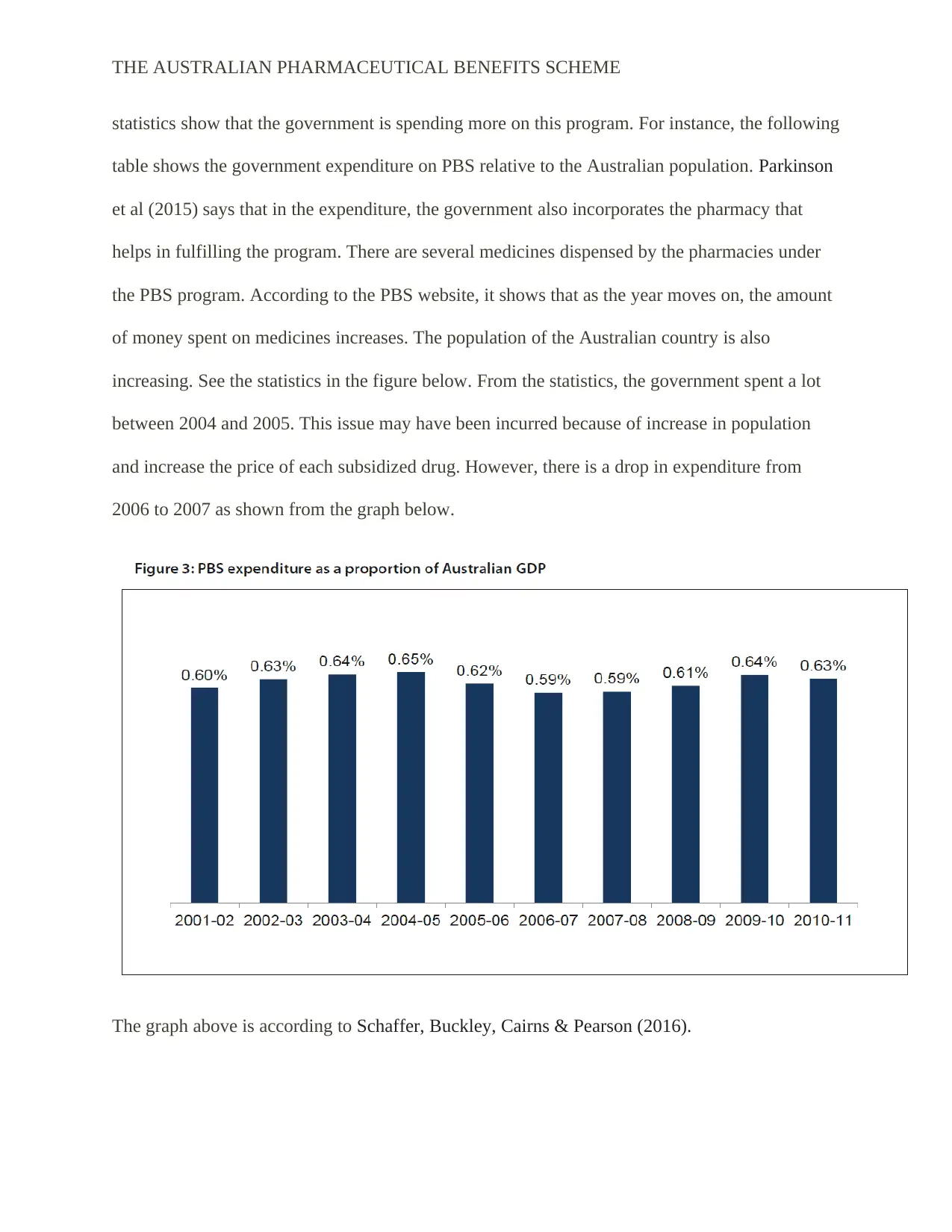
THE AUSTRALIAN PHARMACEUTICAL BENEFITS SCHEME
statistics show that the government is spending more on this program. For instance, the following
table shows the government expenditure on PBS relative to the Australian population. Parkinson
et al (2015) says that in the expenditure, the government also incorporates the pharmacy that
helps in fulfilling the program. There are several medicines dispensed by the pharmacies under
the PBS program. According to the PBS website, it shows that as the year moves on, the amount
of money spent on medicines increases. The population of the Australian country is also
increasing. See the statistics in the figure below. From the statistics, the government spent a lot
between 2004 and 2005. This issue may have been incurred because of increase in population
and increase the price of each subsidized drug. However, there is a drop in expenditure from
2006 to 2007 as shown from the graph below.
The graph above is according to Schaffer, Buckley, Cairns & Pearson (2016).
statistics show that the government is spending more on this program. For instance, the following
table shows the government expenditure on PBS relative to the Australian population. Parkinson
et al (2015) says that in the expenditure, the government also incorporates the pharmacy that
helps in fulfilling the program. There are several medicines dispensed by the pharmacies under
the PBS program. According to the PBS website, it shows that as the year moves on, the amount
of money spent on medicines increases. The population of the Australian country is also
increasing. See the statistics in the figure below. From the statistics, the government spent a lot
between 2004 and 2005. This issue may have been incurred because of increase in population
and increase the price of each subsidized drug. However, there is a drop in expenditure from
2006 to 2007 as shown from the graph below.
The graph above is according to Schaffer, Buckley, Cairns & Pearson (2016).
⊘ This is a preview!⊘
Do you want full access?
Subscribe today to unlock all pages.

Trusted by 1+ million students worldwide
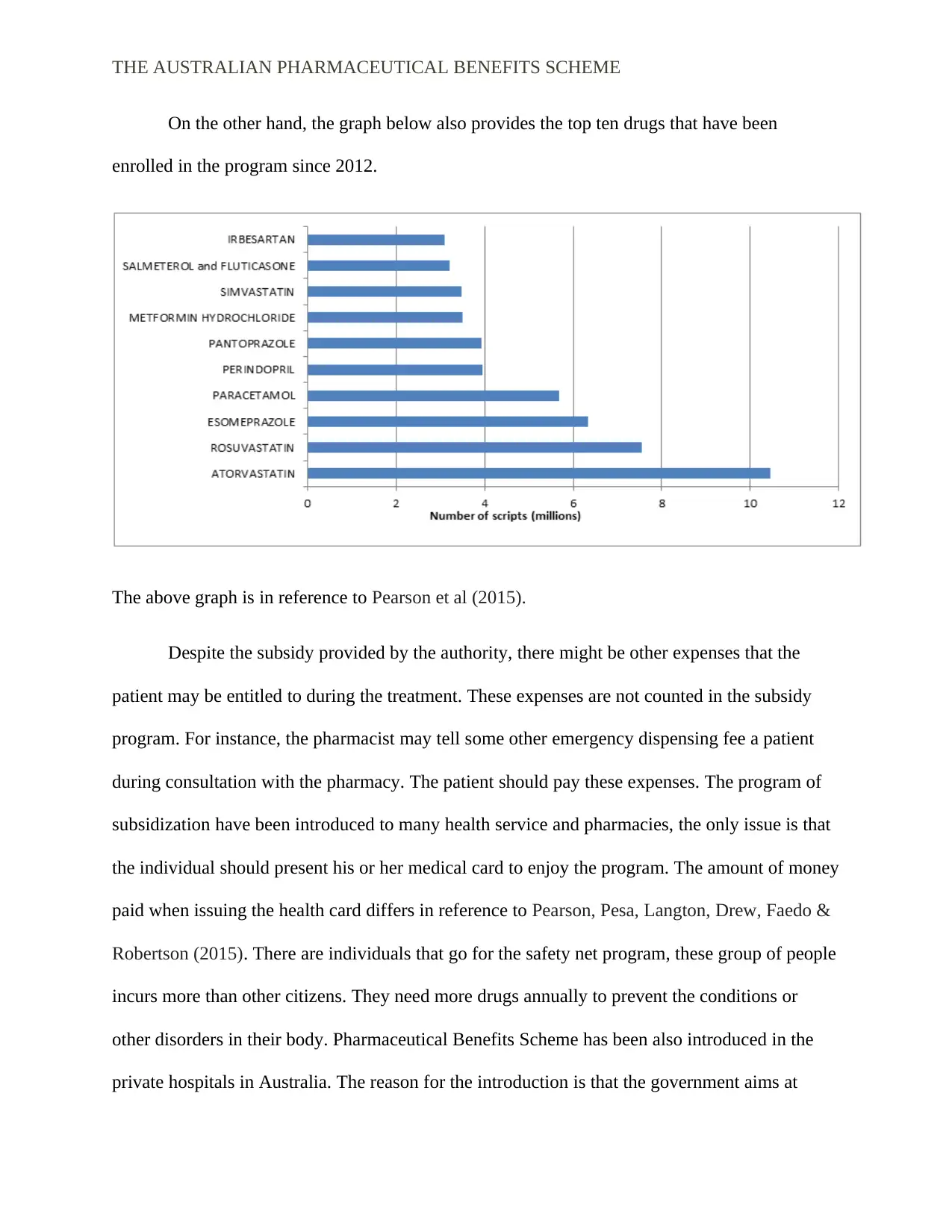
THE AUSTRALIAN PHARMACEUTICAL BENEFITS SCHEME
On the other hand, the graph below also provides the top ten drugs that have been
enrolled in the program since 2012.
The above graph is in reference to Pearson et al (2015).
Despite the subsidy provided by the authority, there might be other expenses that the
patient may be entitled to during the treatment. These expenses are not counted in the subsidy
program. For instance, the pharmacist may tell some other emergency dispensing fee a patient
during consultation with the pharmacy. The patient should pay these expenses. The program of
subsidization have been introduced to many health service and pharmacies, the only issue is that
the individual should present his or her medical card to enjoy the program. The amount of money
paid when issuing the health card differs in reference to Pearson, Pesa, Langton, Drew, Faedo &
Robertson (2015). There are individuals that go for the safety net program, these group of people
incurs more than other citizens. They need more drugs annually to prevent the conditions or
other disorders in their body. Pharmaceutical Benefits Scheme has been also introduced in the
private hospitals in Australia. The reason for the introduction is that the government aims at
On the other hand, the graph below also provides the top ten drugs that have been
enrolled in the program since 2012.
The above graph is in reference to Pearson et al (2015).
Despite the subsidy provided by the authority, there might be other expenses that the
patient may be entitled to during the treatment. These expenses are not counted in the subsidy
program. For instance, the pharmacist may tell some other emergency dispensing fee a patient
during consultation with the pharmacy. The patient should pay these expenses. The program of
subsidization have been introduced to many health service and pharmacies, the only issue is that
the individual should present his or her medical card to enjoy the program. The amount of money
paid when issuing the health card differs in reference to Pearson, Pesa, Langton, Drew, Faedo &
Robertson (2015). There are individuals that go for the safety net program, these group of people
incurs more than other citizens. They need more drugs annually to prevent the conditions or
other disorders in their body. Pharmaceutical Benefits Scheme has been also introduced in the
private hospitals in Australia. The reason for the introduction is that the government aims at
Paraphrase This Document
Need a fresh take? Get an instant paraphrase of this document with our AI Paraphraser
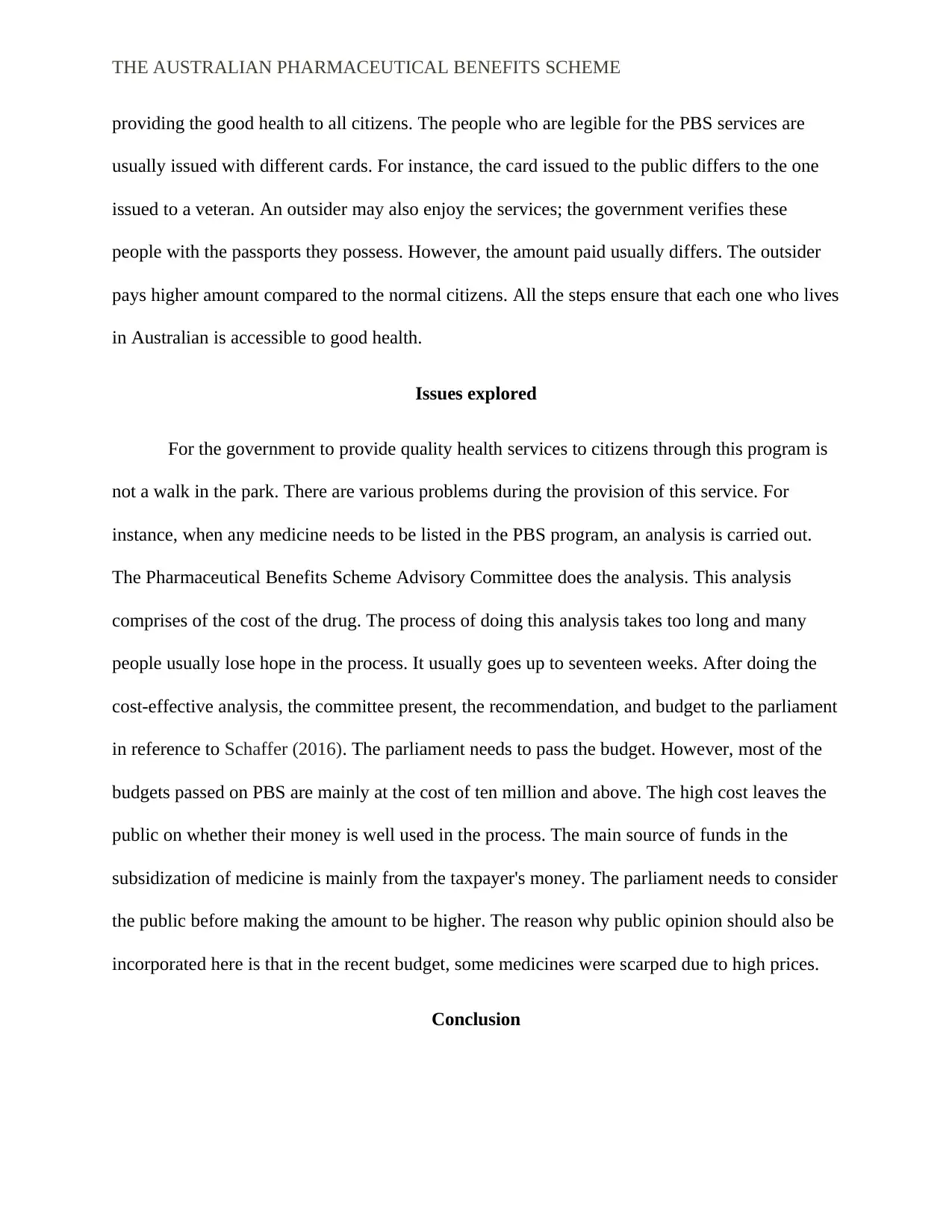
THE AUSTRALIAN PHARMACEUTICAL BENEFITS SCHEME
providing the good health to all citizens. The people who are legible for the PBS services are
usually issued with different cards. For instance, the card issued to the public differs to the one
issued to a veteran. An outsider may also enjoy the services; the government verifies these
people with the passports they possess. However, the amount paid usually differs. The outsider
pays higher amount compared to the normal citizens. All the steps ensure that each one who lives
in Australian is accessible to good health.
Issues explored
For the government to provide quality health services to citizens through this program is
not a walk in the park. There are various problems during the provision of this service. For
instance, when any medicine needs to be listed in the PBS program, an analysis is carried out.
The Pharmaceutical Benefits Scheme Advisory Committee does the analysis. This analysis
comprises of the cost of the drug. The process of doing this analysis takes too long and many
people usually lose hope in the process. It usually goes up to seventeen weeks. After doing the
cost-effective analysis, the committee present, the recommendation, and budget to the parliament
in reference to Schaffer (2016). The parliament needs to pass the budget. However, most of the
budgets passed on PBS are mainly at the cost of ten million and above. The high cost leaves the
public on whether their money is well used in the process. The main source of funds in the
subsidization of medicine is mainly from the taxpayer's money. The parliament needs to consider
the public before making the amount to be higher. The reason why public opinion should also be
incorporated here is that in the recent budget, some medicines were scarped due to high prices.
Conclusion
providing the good health to all citizens. The people who are legible for the PBS services are
usually issued with different cards. For instance, the card issued to the public differs to the one
issued to a veteran. An outsider may also enjoy the services; the government verifies these
people with the passports they possess. However, the amount paid usually differs. The outsider
pays higher amount compared to the normal citizens. All the steps ensure that each one who lives
in Australian is accessible to good health.
Issues explored
For the government to provide quality health services to citizens through this program is
not a walk in the park. There are various problems during the provision of this service. For
instance, when any medicine needs to be listed in the PBS program, an analysis is carried out.
The Pharmaceutical Benefits Scheme Advisory Committee does the analysis. This analysis
comprises of the cost of the drug. The process of doing this analysis takes too long and many
people usually lose hope in the process. It usually goes up to seventeen weeks. After doing the
cost-effective analysis, the committee present, the recommendation, and budget to the parliament
in reference to Schaffer (2016). The parliament needs to pass the budget. However, most of the
budgets passed on PBS are mainly at the cost of ten million and above. The high cost leaves the
public on whether their money is well used in the process. The main source of funds in the
subsidization of medicine is mainly from the taxpayer's money. The parliament needs to consider
the public before making the amount to be higher. The reason why public opinion should also be
incorporated here is that in the recent budget, some medicines were scarped due to high prices.
Conclusion

THE AUSTRALIAN PHARMACEUTICAL BENEFITS SCHEME
PBS schedule provides reliable health services to the people of Australia. The process gives
the less fortunate people an opportunity to access good health services like other people.
However, the government should consider the public opinion before setting on the amount to be
contributed by citizens. In addition, some citizens misuse the program. They take the opportunity
to consume more drugs than expected that is why Australia is registering high drug consumption.
The authority should come up with a mechanism to control drug consumption. The people who
need emergency services should also be given the services at ease. It is good that the scheme has
also united the private hospital to provide the subsidized drugs.
PBS schedule provides reliable health services to the people of Australia. The process gives
the less fortunate people an opportunity to access good health services like other people.
However, the government should consider the public opinion before setting on the amount to be
contributed by citizens. In addition, some citizens misuse the program. They take the opportunity
to consume more drugs than expected that is why Australia is registering high drug consumption.
The authority should come up with a mechanism to control drug consumption. The people who
need emergency services should also be given the services at ease. It is good that the scheme has
also united the private hospital to provide the subsidized drugs.
⊘ This is a preview!⊘
Do you want full access?
Subscribe today to unlock all pages.

Trusted by 1+ million students worldwide

THE AUSTRALIAN PHARMACEUTICAL BENEFITS SCHEME
Reference
arris, C. A., Daniels, B., Ward, R. L., & Pearson, S. A. (2017). Retrospective comparison of
Australia's Pharmaceutical Benefits Scheme claims data with prescription data in HER2-
positive early breast cancer patients, 2008-2012. Public Health Research and
Practice, 27(5), 1-9.
Brett, J., Karanges, E. A., Daniels, B., Buckley, N. A., Schneider, C., Nassir, A., ... & Pearson, S.
A. (2017). Psychotropic medication use in Australia, 2007 to 2015: Changes in annual
incidence, prevalence and treatment exposure. Australian & New Zealand Journal of
Psychiatry, 51(10), 990-999.
Faunce, T. (2015). How the Australia-US free trade agreement compromised the pharmaceutical
benefits scheme. Australian Journal of International Affairs, 69(5), 473-478.
Garrety, K., McLoughlin, I., Dalley, A., Wilson, R., & Yu, P. (2016). National electronic health
record systems aswicked projects': The Australian experience. Information Polity, 21(4),
367-381.
Ghabri, S., & Mauskopf, J. (2017). The use of budget impact analysis in the economic evaluation
of new medicines in Australia, England, France and the United States: relationship to
cost-effectiveness analysis and methodological challenges.
Reference
arris, C. A., Daniels, B., Ward, R. L., & Pearson, S. A. (2017). Retrospective comparison of
Australia's Pharmaceutical Benefits Scheme claims data with prescription data in HER2-
positive early breast cancer patients, 2008-2012. Public Health Research and
Practice, 27(5), 1-9.
Brett, J., Karanges, E. A., Daniels, B., Buckley, N. A., Schneider, C., Nassir, A., ... & Pearson, S.
A. (2017). Psychotropic medication use in Australia, 2007 to 2015: Changes in annual
incidence, prevalence and treatment exposure. Australian & New Zealand Journal of
Psychiatry, 51(10), 990-999.
Faunce, T. (2015). How the Australia-US free trade agreement compromised the pharmaceutical
benefits scheme. Australian Journal of International Affairs, 69(5), 473-478.
Garrety, K., McLoughlin, I., Dalley, A., Wilson, R., & Yu, P. (2016). National electronic health
record systems aswicked projects': The Australian experience. Information Polity, 21(4),
367-381.
Ghabri, S., & Mauskopf, J. (2017). The use of budget impact analysis in the economic evaluation
of new medicines in Australia, England, France and the United States: relationship to
cost-effectiveness analysis and methodological challenges.
Paraphrase This Document
Need a fresh take? Get an instant paraphrase of this document with our AI Paraphraser
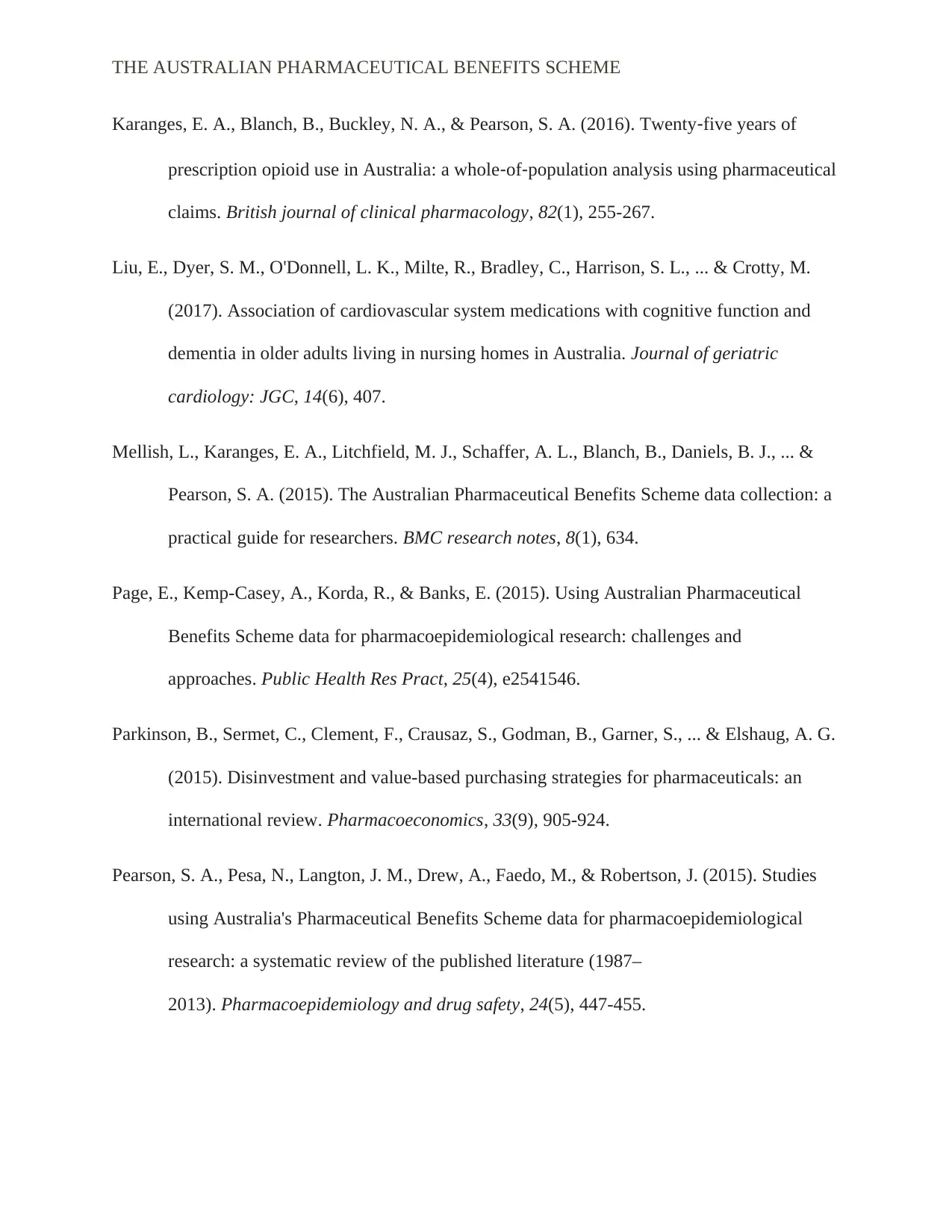
THE AUSTRALIAN PHARMACEUTICAL BENEFITS SCHEME
Karanges, E. A., Blanch, B., Buckley, N. A., & Pearson, S. A. (2016). Twenty‐five years of
prescription opioid use in Australia: a whole‐of‐population analysis using pharmaceutical
claims. British journal of clinical pharmacology, 82(1), 255-267.
Liu, E., Dyer, S. M., O'Donnell, L. K., Milte, R., Bradley, C., Harrison, S. L., ... & Crotty, M.
(2017). Association of cardiovascular system medications with cognitive function and
dementia in older adults living in nursing homes in Australia. Journal of geriatric
cardiology: JGC, 14(6), 407.
Mellish, L., Karanges, E. A., Litchfield, M. J., Schaffer, A. L., Blanch, B., Daniels, B. J., ... &
Pearson, S. A. (2015). The Australian Pharmaceutical Benefits Scheme data collection: a
practical guide for researchers. BMC research notes, 8(1), 634.
Page, E., Kemp-Casey, A., Korda, R., & Banks, E. (2015). Using Australian Pharmaceutical
Benefits Scheme data for pharmacoepidemiological research: challenges and
approaches. Public Health Res Pract, 25(4), e2541546.
Parkinson, B., Sermet, C., Clement, F., Crausaz, S., Godman, B., Garner, S., ... & Elshaug, A. G.
(2015). Disinvestment and value-based purchasing strategies for pharmaceuticals: an
international review. Pharmacoeconomics, 33(9), 905-924.
Pearson, S. A., Pesa, N., Langton, J. M., Drew, A., Faedo, M., & Robertson, J. (2015). Studies
using Australia's Pharmaceutical Benefits Scheme data for pharmacoepidemiological
research: a systematic review of the published literature (1987–
2013). Pharmacoepidemiology and drug safety, 24(5), 447-455.
Karanges, E. A., Blanch, B., Buckley, N. A., & Pearson, S. A. (2016). Twenty‐five years of
prescription opioid use in Australia: a whole‐of‐population analysis using pharmaceutical
claims. British journal of clinical pharmacology, 82(1), 255-267.
Liu, E., Dyer, S. M., O'Donnell, L. K., Milte, R., Bradley, C., Harrison, S. L., ... & Crotty, M.
(2017). Association of cardiovascular system medications with cognitive function and
dementia in older adults living in nursing homes in Australia. Journal of geriatric
cardiology: JGC, 14(6), 407.
Mellish, L., Karanges, E. A., Litchfield, M. J., Schaffer, A. L., Blanch, B., Daniels, B. J., ... &
Pearson, S. A. (2015). The Australian Pharmaceutical Benefits Scheme data collection: a
practical guide for researchers. BMC research notes, 8(1), 634.
Page, E., Kemp-Casey, A., Korda, R., & Banks, E. (2015). Using Australian Pharmaceutical
Benefits Scheme data for pharmacoepidemiological research: challenges and
approaches. Public Health Res Pract, 25(4), e2541546.
Parkinson, B., Sermet, C., Clement, F., Crausaz, S., Godman, B., Garner, S., ... & Elshaug, A. G.
(2015). Disinvestment and value-based purchasing strategies for pharmaceuticals: an
international review. Pharmacoeconomics, 33(9), 905-924.
Pearson, S. A., Pesa, N., Langton, J. M., Drew, A., Faedo, M., & Robertson, J. (2015). Studies
using Australia's Pharmaceutical Benefits Scheme data for pharmacoepidemiological
research: a systematic review of the published literature (1987–
2013). Pharmacoepidemiology and drug safety, 24(5), 447-455.
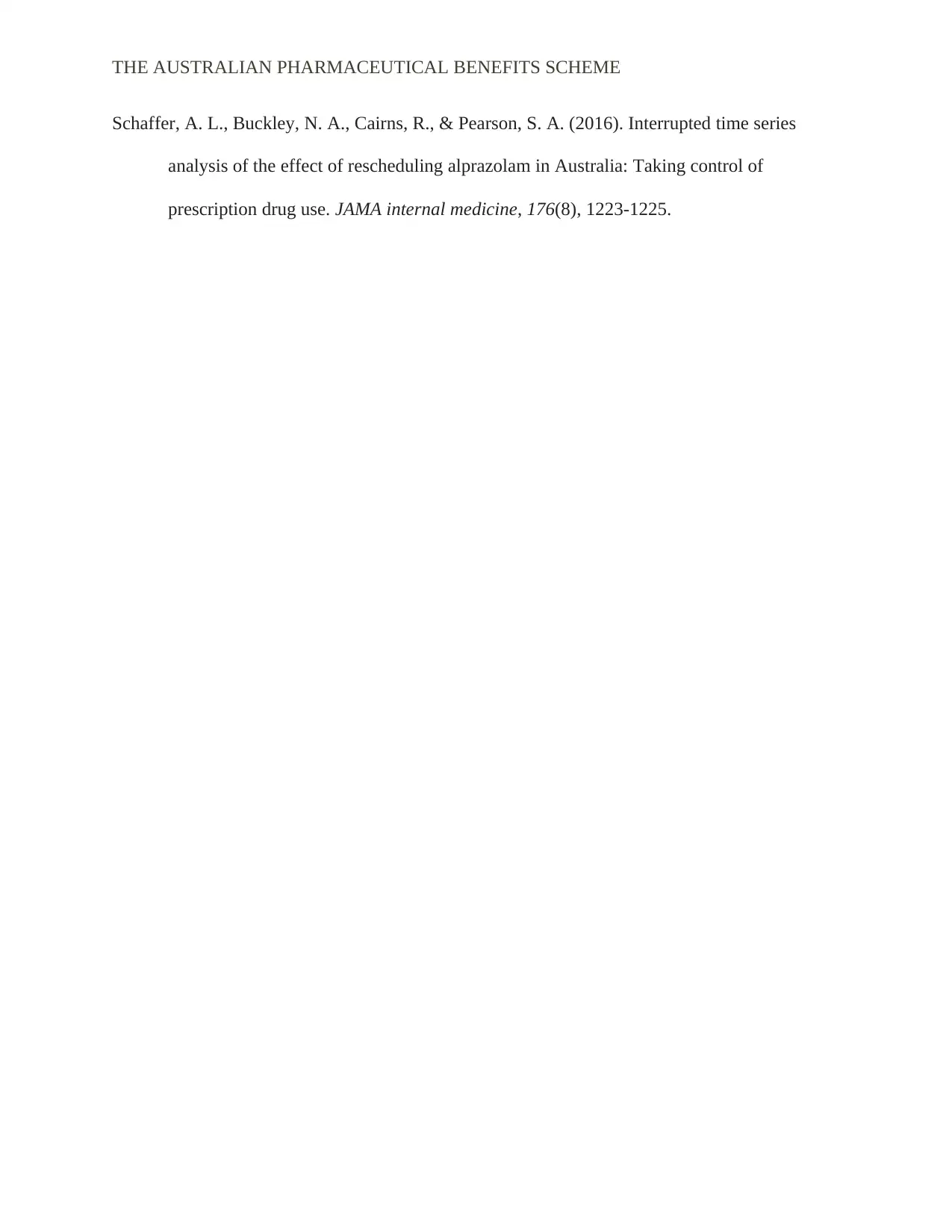
THE AUSTRALIAN PHARMACEUTICAL BENEFITS SCHEME
Schaffer, A. L., Buckley, N. A., Cairns, R., & Pearson, S. A. (2016). Interrupted time series
analysis of the effect of rescheduling alprazolam in Australia: Taking control of
prescription drug use. JAMA internal medicine, 176(8), 1223-1225.
Schaffer, A. L., Buckley, N. A., Cairns, R., & Pearson, S. A. (2016). Interrupted time series
analysis of the effect of rescheduling alprazolam in Australia: Taking control of
prescription drug use. JAMA internal medicine, 176(8), 1223-1225.
⊘ This is a preview!⊘
Do you want full access?
Subscribe today to unlock all pages.

Trusted by 1+ million students worldwide
1 out of 12
Related Documents
Your All-in-One AI-Powered Toolkit for Academic Success.
+13062052269
info@desklib.com
Available 24*7 on WhatsApp / Email
![[object Object]](/_next/static/media/star-bottom.7253800d.svg)
Unlock your academic potential
Copyright © 2020–2025 A2Z Services. All Rights Reserved. Developed and managed by ZUCOL.



